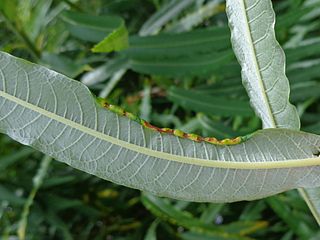
Rabdophaga rosaria is a gall midge which forms Camellia galls or terminal rosette gall on willow species. It was first described by Hermann Loew in 1850.
Synanthedon flaviventris, the sallow clearwing, is a moth of the family Sesiidae. The larvae form pear-shaped galls on sallows.
Rabdophaga clavifex is a gall midge which forms galls on the buds of willow species.
Rabdophaga strobilina is a gall midge and inquiline of Rabdophaga rosaria and Rabdophaga terminalis; also gall midges. It was first described by Johann Jacob Bremi-Wolf in 1847.
Rabdophaga strobilina is a gall midge which forms galls on the buds of some species of willow. It was first described by Hermann Loew in 1850.
Rabdophaga iteobia is a gall midge which forms galls on the buds of willow species.
Rabdophaga heterobia is a species of gall midges which has two generations a year and forms galls on almond willow. It was first described by Hermann Loew in 1850.
Rabdophaga jaapi is a species of gall midges which forms galls on creeping willow.

Rabdophaga rosariella is a species of gall midge which forms galls on sallows. It was first described by Jean-Jacques Kieffer in 1897.
Rabdophaga saliciperda is a species of gall midges which forms galls on willows. It was first described by Léon Jean Marie Dufour in 1841.

Rabdophaga salicis is a gall midge which forms galls on sallows. It was first described by Franz von Paula Schrank in 1803.
Rabdophaga albipennis is a gall midge which forms galls on the shoots of white willow.
Rabdophaga karschi is a gall midge which forms galls on the twigs of sallows.
Rabdophaga dubiosa is a gall midge which forms galls on the young shoots of willow.

Cydia servillana is a moth of the family Tortricidae which forms galls on the young shoots of willow. It was first described by Philogène Auguste Joseph Duponchel in 1836.
Rabdophaga exsiccans is a gall midge. It was first described by Ewald Heinrich Rübsaamen in 1916. The larvae tunnel in the shoots of creeping willow and may cause the shoots to swell slightly.

Rabdophaga marginemtorquens is a gall midge which forms galls on willows and is found in Europe. It was described by Johann Jacob Bremi-Wolf in 1847.
Rabdophaga roskami is a gall midge which may form galls on common ossier or, the larva live in the galls formed by R. marginemtorquens. It was first described by H Stelter in 1989.
Rabdophaga clausilia is a gall midge which, depending on the source, forms galls on the leaves of willows, or is an inquiline living in the galls of a Rabdophaga species, or a predator. It was first described by Johann Jacob Bremi-Wolf in 1847.

Rabdophaga nervorum is a gall midge which forms galls on the leaves of sallows. It is found in Europe and was first described by the French entomologist, Jean-Jacques Kieffer in 1895.






